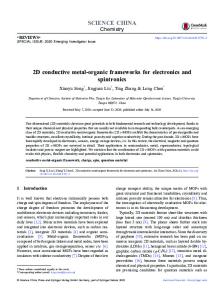Raman Spectroscopy for Probing guest-host interactions in Metal Organic Frameworks
- PDF / 436,797 Bytes
- 5 Pages / 612 x 792 pts (letter) Page_size
- 5 Downloads / 291 Views
Raman Spectroscopy for Probing guest-host interactions in Metal Organic Frameworks 1
Nour Nijem1, Katy Roodenko1, Yonggang Zhao2, Jing Li2 and Yves J. Chabal1 Department of Materials Science and Engineering, University of Texas at Dallas, Richardson, Texas 75080, U.S.A. 2 Department of Chemistry and Chemical Biology, Rutgers University, 610 Taylor Road, Piscataway, New Jersey 08854, U.S.A.
ABSTRACT Spectroscopic techniques such as IR and Raman are very powerful to understand guesthost interactions. Although these techniques are complementary, Raman spectroscopy has not been widely implemented as a tool to characterize these interactions. This study illustrates the use of Raman spectroscopy not only to probe the interactions experienced by a guest molecule but also to detect structural changes occurring in the framework upon loading. Weak interactions of adsorbed molecules with the framework are reflected in frequency and intensity variations in both Raman and IR absorption lines, as shown for the case of CO2, N2 and CH4 with Zn(bdc)(ted)0.5. INTRODUCTION Raman Spectroscopy is a powerful tool to study interactions of adsorbates in porous materials. It is a technique complementary to infrared (IR) spectroscopy due to different selection rules. Indeed, centrosymetrical molecules can have either an IR or Raman modes; for example the CO2 IR absorption due to the C=O asymmetric stretching mode is only IR active, while the symmetric C=O vibration is only Raman active. Raman has not been widely used to study adsorption in Metal Organic Frameworks (MOFs).1-3 Most of the studies of interactions of CO2 with MOFs has been done using IR spectroscopy.4 We demonstrate here the value to use a combination of IR and Raman to probe interactions of CO2, N2 and CH4 in Metal Organic Frameworks (MOFs). Metal Organic Frameworks (MOFs) are microporous materials that are composed of a metal center and organic ligands constructing 3 D porous structures. MOFs have been considered for CO2 separation because their pore size and functionalities can be tuned to selectively adsorb CO2.5-7 Characterization of such materials for CO2 separation has been primarily by the use of isotherms, giving information about the CO2 uptake, selectivity and isosteric heat of adsorption. However, we have shown in a recent study that isotherms alone cannot give information about intermolecular interaction as we showed for H2 molecules in unsaturated MOF systems (e.g., MOF-74).8-10 This work will show the use of Raman spectroscopy in the characterization of adsorption of small molecules such as CO2, N2 and CH4 in Zn(bdc)(ted)0.5 where bdc= 1,4 benzenedicarboxylate and ted= triethylenediameine). Zn(bdc)(ted)0.5 is a 3-D porous structure that crystallizes in the tetragonal crystal system (space group P4/ncc). This framework is composed of a paddle-wheel M2(COO)4 secondary building unit (SBU) that is connected via the
bdc and ted ligand to form the 3-D porous structure. This MOF has a pore size of (~7-8 Å), pore volume (~0.63-0.84 cm3/g) and BET surface area (~1500-1
Data Loading...











